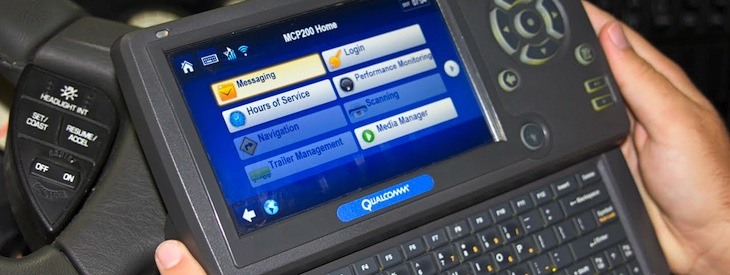Industry experts offer advice on ELD mandate, discuss impact since full enforcement
by July 9, 2018 4:40 pm 435 views

Full enforcement of the electronic logging device (ELD) mandate has been in effect since April 1, and carriers prepared for it are in a better position to succeed while federal officials continue to roll out guidance on the devices, according to market watchers.
The ELD mandate went into effect Dec. 18, but roadside inspectors agreed to not start placing trucks out of service for violations of the mandate until April 1. Recently, the Federal Motor Carrier Safety Administration (FMCSA) updated guidance on personal conveyance as it relates to ELDs and that they are not required for truck drivers hauling livestock or agricultural products within a 150-mile radius. Also, those who opted to use an automatic on-board recording device (AOBRD) to comply with the mandate won’t be required to use an ELD until December 2019.
In a recent webinar hosted by industry source Transport Topics, experts offered advice and discussed the impacts of the mandate on the industry three months after full enforcement. Kerri Wirachowsky, director of the Roadside Inspection Program for the Commercial Vehicle Safety Alliance, said with between 200 and 300 ELDs on the market, drivers need to be properly trained on their device and to know what device they have to expedite roadside inspections.
Some drivers are unaware of whether they have an AOBRD or an ELD. When inspectors ask for a digital copy of the driver’s log, an AOBRD sends the info via portable document format (pdf), but an ELD sends it through web services, Wirachowsky said. Also, drivers are expected to have an instruction card on the device in their cab. It’s a separate offense for drivers who do not have the card, and in case the ELD malfunctions, drivers should keep a paper logs as a backup.
Wirachowsky said drivers who’ve used ELDs like them as they automatically maintain driver logs and eliminate possible violations. Before, when a driver forgot to update paper driving logs, they could face a citation. With ELDs, they allow inspectors to focus more on hours of service. Nothing has changed with hours of service rules as a result of the ELD mandate, said Wirachowsky, adding that hours of service is tracked with electronic logs instead of paper logs.
Also, she said the recent guidance from the FMCSA has cleared up driver concerns over being told to move when they are at a loading dock or on the side of the road but trying to get their 10-hour rest break. And, paper logs don’t tell drivers when they are close to reach their hours of service limit, but ELDs assist drivers with this, she said. Driver logs are more difficult to falsify now, and while she’s unaware of any specific ways to cheat with an ELD, she said there probably are ways to do so.
RISE OF ELDs
Some of the major events leading up to the ELD mandate started in the 1990s with satellite tracking, mobile communications, management systems and U.S. Environmental Protection Agency regulations, said Tom McLeod, president of McLeod Software. Most of the “better managed” carriers were already prepared for the mandate, yet it’s constrained capacity across the industry between 5% and 7% as the industry faces a capacity crunch.
“Disruption always creates opportunity,” said McLeod, adding that he doesn’t think the disruption as a result of the ELD mandate with be “cataclysmic.”
In comparison to the ELD mandate, with the advent of mobile communications in the 1990s, drivers were concerned about the big brother effect. But mobile communications allowed drivers to find their next load without having to find a phone to make a call. Now, with ELDs, drivers don’t have to fill out paper logs anymore. The ELD mandate puts everyone on a level playing field, he said.
Along with the ELD mandate, other factors creating tightness in the market include a strong economy, plentiful freight and the driver shortage. But carriers who are better prepared to handle the constraints will have better relationships with shippers, he said. Carriers can maintain existing service levels through visibility of their drivers’ available hours of service. Those that are always looking to improve productivity will be successful.
“Drivers that are 5%-10% more productive are going to win in the marketplace,” McLeod said. It will set apart the companies that are better managed and “weed out” the others.
CARRIERS PREPARE
Edin Selimagic, safety manager for Midwest Freight System of Warren, Mich., said the carrier started installing ELDs about a year before the mandate went into effect. At first, the most difficult part of the process was the driver pushback. But after they understood that the issue wasn’t going away, they accepted it.
Now, he’s drivers tell him they couldn’t be happier with electronic logs as the drivers are earning more money and getting more rest.
Selimagic said the company offers a 24-hour ELD helpline for drivers, and its provider Omnitracs monitors driver behavior and will reach out to a driver in the event of unsafe or aggressive driving. With the ELDs, drivers are more confident when stopped for a roadside inspection.
“Everything is there for them to see,” he said.
In an October 2017 blog post, Tontitown-based carrier P.A.M. Transportation Services, said the company would convert to AOBRDs to comply with the ELD mandate and outfit all its owner operators with the devices for free and without a rental charge. Carriers and drivers that installed AOBRDs before Dec. 18, 2017, will have until Dec. 16, 2019, to switch to ELDs.
In a November 2017 blog post, ELD provider KeepTruckin said owner operators for Van Buren-based carrier USA Truck would receive a 20% discount on the provider’s ELDs. Drivers of ABF Freight, the less-than-truckload carrier of Fort Smith-based ArcBest, have used ELDs since Feb. 1, 2017. Also, Lowell-based carrier J.B. Hunt Transport Services’ trucks were ELD compliant before the mandate went into effect.
